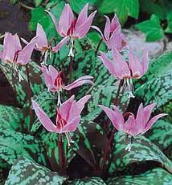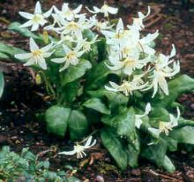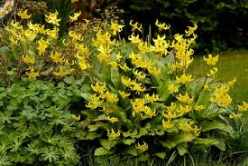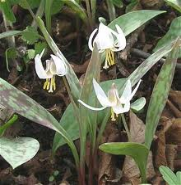Dog's tooth violets, Erythronium species
Dog's tooth violet, Erythronium dens-canis
The bulb is edible raw or cooked and used as a vegetable.
It can be dried to make a flour and is also the source of a starch used in making 'vermicelli' and cakes.
The leaves can be eaten cooked. Eating the leaves will greatly reduce the vigour of the bulb, so can only be recommended in times of emergency.

 Trout lily, variety Pagoda or white beauty, Erythronium revolutum
Trout lily, variety Pagoda or white beauty, Erythronium revolutum
The bulb can be eaten raw or cooked. It can also be dried and stored for later use.
The bulbs are usually harvested in the spring as the first leaves appear above ground, they can be stored for some months in a cool place.
The raw bulb has a slightly bitter milky taste, the texture is cool and moist inside and so the North American Indians liked eating them on hot days.
The cooked bulb has a more starchy texture.
The Indians always drank water after eating the bulbs because they believed that otherwise they would get sick.
The ovoid bulb is 35 - 50mm long.
Erythronium albidum
The bulb can be eaten raw or cooked. A delicious flavour.
Rather small, it is about 25mm long.
The young leaves are edible raw or cooked. Crisp, tasty, tender and mild when eaten raw.
Eating the leaves will greatly reduce the vigour of the bulb, so can only be recommended in times of emergency.
Flowers, flower buds and flower stems are edible raw or cooked.
